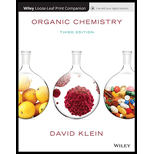
Concept explainers
(a)
Interpretation: Efficient synthesis for the given transformation has to be proposed.
Concept Introduction:
First step is the formation of more stable carbocation which is followed by the attack of nucleophile. Formation of more stable carbocation and the leaving group present in the substrate plays very important role in the reactivity of
Bromination: In bromination reaction, hydrogen atom of a molecule is replaced by a bromine atom.
In a reaction,
(b)
Interpretation: Efficient synthesis for the given transformation has to be proposed.
Concept Introduction:
Elimination Reaction: It is just reverse reaction of addition where substituent from the given molecule is removed.
E2 mechanism depends on both base and substituents in the reaction.
Elimination reaction of an
Bromination: In bromination reaction, hydrogen atom of a molecule is replaced by a bromine atom.
In a reaction,
(c)
Interpretation: Efficient synthesis for the given transformation has to be proposed.
Concept Introduction:
Structure of the substrate plays major role in the reactivity of
Bromination: In bromination reaction, hydrogen atom of a molecule is replaced by a bromine atom.
In a reaction,
(d)
Interpretation: Efficient synthesis for the given transformation has to be proposed.
Concept Introduction:
First step is the formation of more stable carbocation which is followed by the attack of nucleophile. Formation of more stable carbocation and the leaving group present in the substrate plays very important role in the reactivity of
Bromination: In bromination reaction, hydrogen atom of a molecule is replaced by a bromine atom.
In a reaction,
(e)
Interpretation: Efficient synthesis for the given transformation has to be proposed.
Concept Introduction:
Ozonolysis:
Alkene reacts with ozone which cleaves the double bond followed by work up with dimethyl sulfide forms

Elimination Reaction: It is just reverse reaction of addition where substituent from the given molecule is removed.
E2 mechanism depends on both base and substituents in the reaction.
Elimination reaction of an alkyl halide results in the formation of an alkene.
Bromination: In bromination reaction, hydrogen atom of a molecule is replaced by a bromine atom.
In a reaction,
(f)
Interpretation: Efficient synthesis for the given transformation has to be proposed.
Concept Introduction:
Ozonolysis:
Alkene reacts with ozone which cleaves the double bond followed by work up with dimethyl sulfide forms ketone.

Elimination Reaction: It is just reverse reaction of addition where substituent from the given molecule is removed.
E2 mechanism depends on both base and substituents in the reaction.
Bromination: In bromination reaction, hydrogen atom of a molecule is replaced by a bromine atom.
In a reaction,
The Grignard reaction:
Alkyl, vinyl, or aryl-magnesium halides (
Grignard reagent is reaction with carbonyl compound such as

Want to see the full answer?
Check out a sample textbook solution
Chapter 17 Solutions
ORGANIC CHEMISTRY-PRINT COMPANION (LL)
 ChemistryChemistryISBN:9781305957404Author:Steven S. Zumdahl, Susan A. Zumdahl, Donald J. DeCostePublisher:Cengage Learning
ChemistryChemistryISBN:9781305957404Author:Steven S. Zumdahl, Susan A. Zumdahl, Donald J. DeCostePublisher:Cengage Learning ChemistryChemistryISBN:9781259911156Author:Raymond Chang Dr., Jason Overby ProfessorPublisher:McGraw-Hill Education
ChemistryChemistryISBN:9781259911156Author:Raymond Chang Dr., Jason Overby ProfessorPublisher:McGraw-Hill Education Principles of Instrumental AnalysisChemistryISBN:9781305577213Author:Douglas A. Skoog, F. James Holler, Stanley R. CrouchPublisher:Cengage Learning
Principles of Instrumental AnalysisChemistryISBN:9781305577213Author:Douglas A. Skoog, F. James Holler, Stanley R. CrouchPublisher:Cengage Learning Organic ChemistryChemistryISBN:9780078021558Author:Janice Gorzynski Smith Dr.Publisher:McGraw-Hill Education
Organic ChemistryChemistryISBN:9780078021558Author:Janice Gorzynski Smith Dr.Publisher:McGraw-Hill Education Chemistry: Principles and ReactionsChemistryISBN:9781305079373Author:William L. Masterton, Cecile N. HurleyPublisher:Cengage Learning
Chemistry: Principles and ReactionsChemistryISBN:9781305079373Author:William L. Masterton, Cecile N. HurleyPublisher:Cengage Learning Elementary Principles of Chemical Processes, Bind...ChemistryISBN:9781118431221Author:Richard M. Felder, Ronald W. Rousseau, Lisa G. BullardPublisher:WILEY
Elementary Principles of Chemical Processes, Bind...ChemistryISBN:9781118431221Author:Richard M. Felder, Ronald W. Rousseau, Lisa G. BullardPublisher:WILEY





